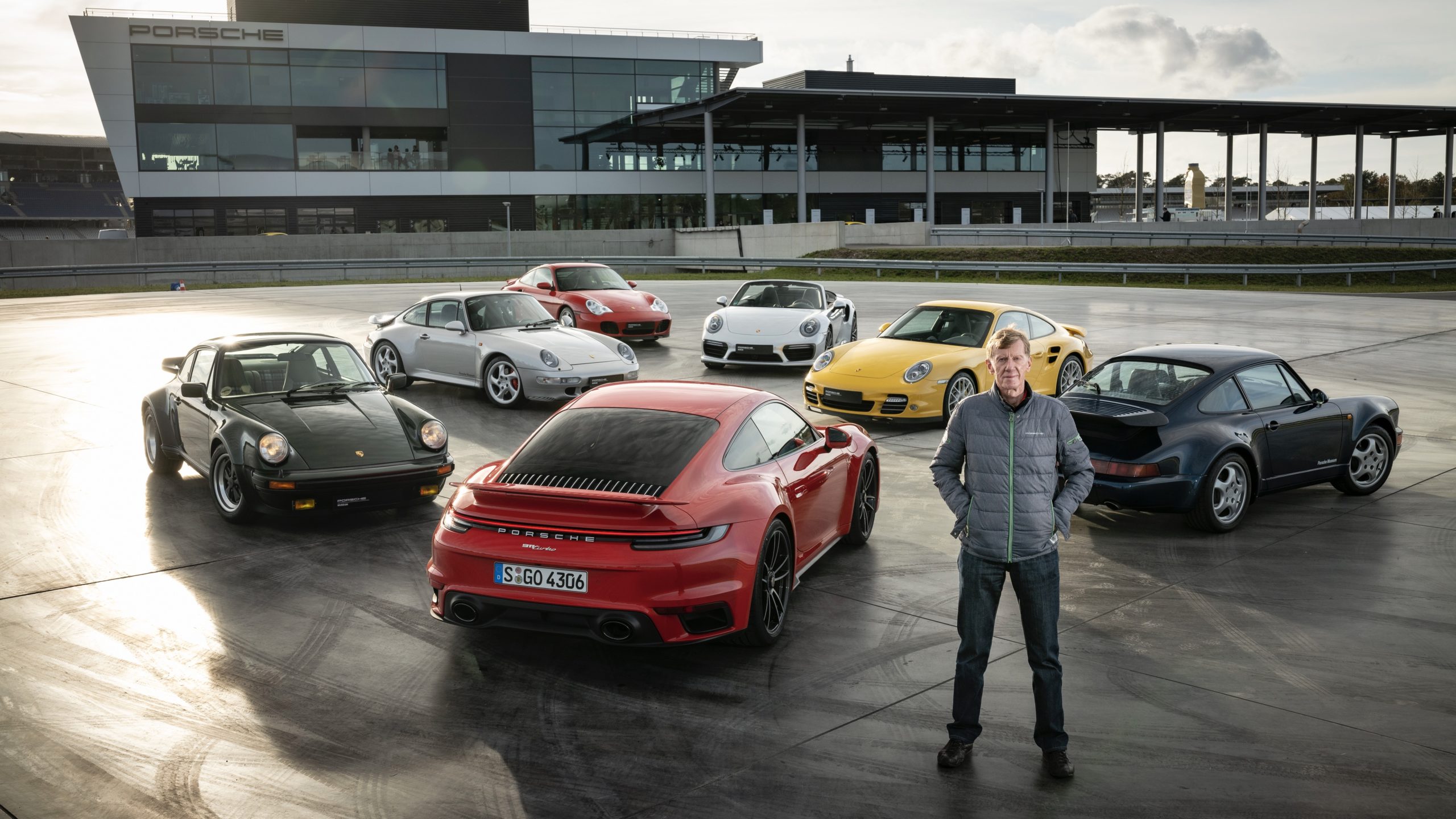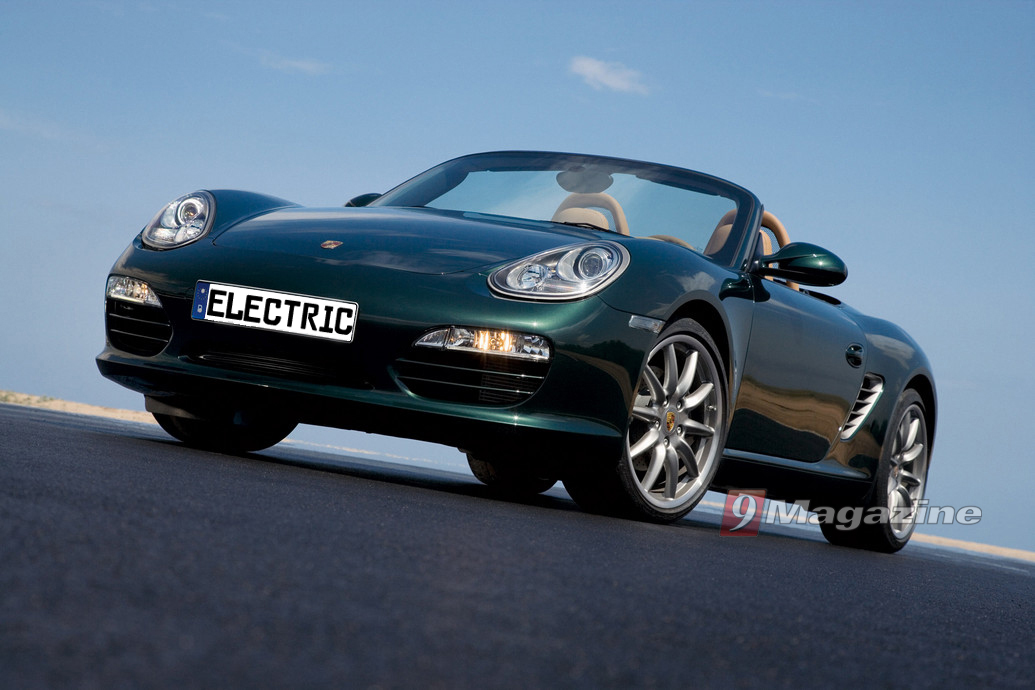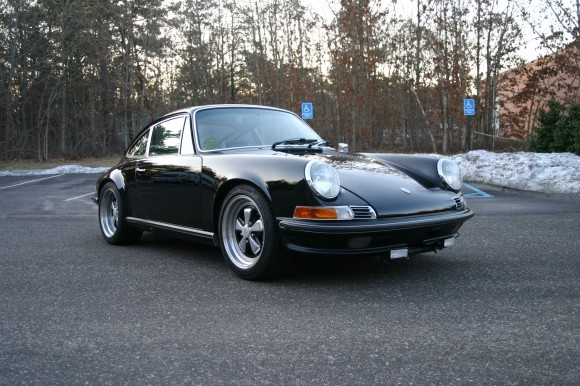 When is an early Porsche 911 not an early 911? Starting with the first generation of 911, owners have modified their cars for performance and aesthetics. In the late 70’s and early 80’s it was common to see earlier ‘longhood’ 911s updated to look like the current crop of more modern, ‘impact-bumper’ cars. Ironically, the reverse of this process is now a popular technique referred to in the 911 world as ‘backdating’
When is an early Porsche 911 not an early 911? Starting with the first generation of 911, owners have modified their cars for performance and aesthetics. In the late 70’s and early 80’s it was common to see earlier ‘longhood’ 911s updated to look like the current crop of more modern, ‘impact-bumper’ cars. Ironically, the reverse of this process is now a popular technique referred to in the 911 world as ‘backdating’
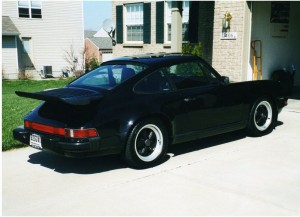 The car you see here started life as a 1988 Carrera. From the factory the car came with Porsche’s 3.2 engine, which could trace it’s lineage all the way back to the first 911 in 1964. Years of refinement gave the engine and car a reputation for having ‘bulletproof’ reliability. This car also benefits from being fully galvanized, a process Porsche finally incorporated in the late ‘70s. Lastly, the car had power windows, a sunroof, and air conditioning.
The car you see here started life as a 1988 Carrera. From the factory the car came with Porsche’s 3.2 engine, which could trace it’s lineage all the way back to the first 911 in 1964. Years of refinement gave the engine and car a reputation for having ‘bulletproof’ reliability. This car also benefits from being fully galvanized, a process Porsche finally incorporated in the late ‘70s. Lastly, the car had power windows, a sunroof, and air conditioning.
Now in the possession of it’s fifth owner, the details of the car are intriguing and indicative of the power of online car communities. The car has passed hands through a succession of members of the Pelican Parts forum, and many of the upgrades were done as the result of friendships and connections made there.
It was the car’s third owner who took it upon himself to update the mechanicals and underpinnings of the car. When the opportunity to purchase an additional 1993 Targa with a hot-rodded 3.6 twin plug engine presented itself, the owner did the math and realized that he could do an engine swap with this car, and then sell the ‘93. Once he started, it was natural to contact Patrick Motorsports and order up a shortened bell housing to accommodate the G50 transmission already in the car, and also add a single-mass lightweight flywheel.
Not content with what amounted to a significant bump in horsepower and torque, it was now time to address the chassis. Larger (22mm) front and (30mm) rear sway bars were added to the car, along with a front strut tower brace and new monoballs. That might have been enough to turn the car into an even sharper tool for the curves, but the suspension work wouldn’t have really been complete without a set of Elephant Racing’s poly-bronze bushings all around and larger 993 brakes with 930 rotors and master cylinder.
By the time the car reached the fourth owner’s hands, it had cup car bumpers, a whale tail spoiler, and aftermarket wheels. It was obviously a track tool, and a well sorted one at that. The new owner decided that although the car was at a mechanical peak, the exterior needed some reigning in. Visions of early cars with their long hoods and lightweight bumpers must have been appealing.
The vision was to create something different from the current trend of building a backdate to resemble the ’72-’73 Carrera RS. Enlisting the help of TRE Motorsports and Axiom Auto Body, the car began its exterior transformation. Fiberglass fenders, bumpers and hood were fitted. The window trim was stripped, polished, and anodized. Gone was the rear window with it’s center mounted third brake light, and while out, a new period correct white headliner was installed. When finished, the car looked like a true early car, albeit with slightly flared rear arches reminiscent of the ‘73 RS but without the ducktail spoiler or bodyside graphics. It was truly an elegant looking, yet menacingly powerful machine.
Now in the hands of it’s current (5th) owner, the car was almost perfect. What nagged at the new owner was the one area that almost all backdates neglect; the interior. Backdating the exterior of a later car isn’t a difficult process. All of the exterior panels are available, and because they’re in fiberglass, prices are attractive. It’s the interior that’s tricky. Later cars have updated dashboards with two and sometimes four vents to accommodate ventilation, later gauges, and a center console for the shifter and controls.
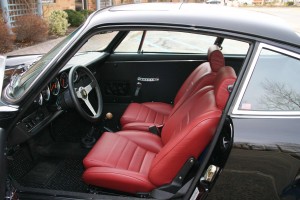 As you see it now, this backdated car has had its interior gutted and completely reworked. New RS carpets, custom red leather GTS Classics ‘Sport S’ seats (with heat) were installed, and door cards were designed and fabricated by the owner. The lower dash was rebuilt to resemble an early 911, and the upper dash is a Coverlay cover, cleverly modified to have the all important speaker grill present. North Hollywood speedometer was tasked with rebuilding the later gauges to resemble period-correct ones. Dashboard rallye timers by Heuer and seatbelts rebuilt to resemble vintage Autoflug harnesses lend an air of authenticity to the interior.
As you see it now, this backdated car has had its interior gutted and completely reworked. New RS carpets, custom red leather GTS Classics ‘Sport S’ seats (with heat) were installed, and door cards were designed and fabricated by the owner. The lower dash was rebuilt to resemble an early 911, and the upper dash is a Coverlay cover, cleverly modified to have the all important speaker grill present. North Hollywood speedometer was tasked with rebuilding the later gauges to resemble period-correct ones. Dashboard rallye timers by Heuer and seatbelts rebuilt to resemble vintage Autoflug harnesses lend an air of authenticity to the interior.
So when is an early car not an early car? When beneath its paint lies a factory galvanized body, beneath it’s engine lid lies a twin plug 3.6, and inside it’s doors are a combination of new comfort disguised by old class. Pressed to sum up the modifications to the car, it’s current owner simply says, “classic grace and modern pace”.
Build Details
The car started as a 1988 Carrera. It was chosen for several reasons; one is the galvanized body, the fact that it is a relatively common chassis, the hydraulic clutch and G50 gearbox, the good AC, etc. The chassis has 140,000 miles on it.
The engine is a 964 engine with roughly 60k miles. The 3.6 liter ’93 engine was exported from Europe by Harald (speedster94 on Pelican) several years ago. Harald said that the previous owner blueprinted it to RS specs, but I have no documentation of that. However, he spoke VERY highly of the engine:
“The pre owner was a Porsche Cupper, that is a Cup Car mechanic in a Cup car Team. To me that is a RS engine in a Street case, if you look underneath you will find some marks, like RS or Cup . They usually did that with Race parts in the Factory. That Engine is special and I have had at least 100 964 and 993, this was outstanding and even a 3.8 isn’t any better. So keep it in honor, you will not be able to replace it. I am serious, I still regret selling it.” – Harald
The engine has been nicely detailed with powder coated valve covers and fan. The fan housing is polished and detailed nicely. It has Thom’s carbon fiber heater tube. A Timmons harness was used for the conversion and it has a GIAC chip tuned by Steve Weiner for the lightweight flywheel. Also it has Sport engine mounts and recent fuel pump
Exhaust started as 993 H/Es for heat and defrost. The muffler started as a new Dansk. It was sectioned, folded, mutilated and with Ben’s “RSR” MK tips created something that sounds awesome, but not too loud. And most importantly fit the early bumper set up and fabbed heater ducting so it all works.
Car now has two fender mounted oil coolers , run in series. It has the factory passenger side cooler with fan, activated by dash switch (3.6’s run on the warm side) and a large Setrab on driver side with louvered rock shield. Both sides have been closed in with shrouding on the bottom of the S spoiler.
The clutch assembly for the G50 is a collection of 964 RS stuff- clutch housing, clutch disc, ring gear, guide tube, pilot bearing. Steve Timmons supplied the parts. There are roughly 5K miles on these parts.
Suspension – 22 front/30 rear torsion bars, Bilstein sport shocks, Elephant poly-bronze all around, Elephant strut brace, trailing arm monoballs, turbo tie rods, recently rebuilt steering rack (preventative), new ball joints (preventative), A-Arms stripped and repainted, spring plates cad plated.
Brakes All four basic 993 calipers. The fronts are 44/36 pistons and use adapter blocks made by Dave Walsh (DinFtown on Pelican) at ProBraking. He also made the rotor annulus/hat/adapter and supplied the NAS nuts & bolts and the Wilwood HD 309mm x 32mm (actually 12 in. x 1 .25 in. exactly) rotors.
The rears are 34/30 pistons. The rear caliper mountings were resized by tapping the existing holes to accept an appropriately sized alloy threaded rod. Inserted the rod to plug and red Loctite to hold it in place. Then filed the rod flush with the caliper body and punched the edges of the hole plug. Drilled the new holes in the appropriate location.
The rear rotors are factory 78-89 930 304mm x 28mm rotors. New pads have to be shaved to fit by the way (since the rotor is so wide).
The brake master cylinder is a 78-89 930 vacuum boosted unit that is 23.81mm size to replace the stock 20.64mm master. The stock Carrera rear circuit pressure-limiting valve was removed to achieve the correct bias. .
The choice of the brakes was based on the very knowledgeable advice of Bill Verburg.
The wheels are custom manufactured 17X8 and 17X9 Fuchs made by Lindsey Racing. They are gorgeous in their workmanship, as many on Pelican can attest. The size was required to clear the very effective brakes.
Body; The front fenders, hood, front and rear bumpers are fiberglass by Getty. TRE managed the fitment and paint but the work was done by Axiom. It took a LOT of labor and painstaking effort to get the fitment and finish just right. It is very difficult to tell the parts are fiberglass. The paint is stunning.
The window trim was polished and clear anodized to complete the retro-look. The rear engine grill is an original aluminum grill. The lights are upgraded xenon bulbs and the proper relays installed. The rear tail light assemblies have been replaced.
Interior: The interior has been upgraded with the addition of a vintage Momo steering wheel. The factory carpeting and insulation has been removed and RS carpet has been used to replace it. A custom built Luggage Deposit gives additional (usable) storage space behind the seats. The seats are reproduction Sport S seats by GTS Classics, and have seat heaters with hidden switches. The lower dash has been rebuilt with a combination of original and reproduction parts, and the upper dash is a modified Coverlay. A correct white headliner, Vintage Heuer Rallye timers, and reproduction AutoFlug harnesses complete the look.
Text & Photos By: Mike Deleo


